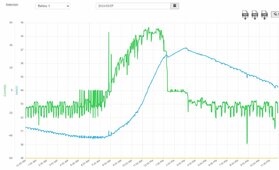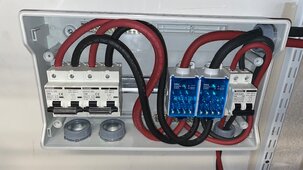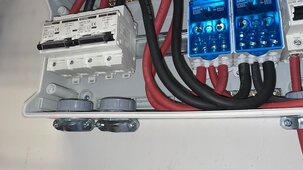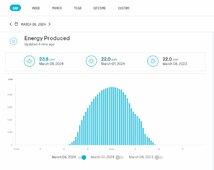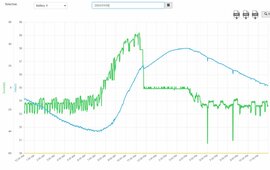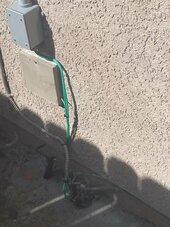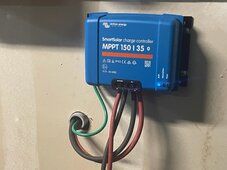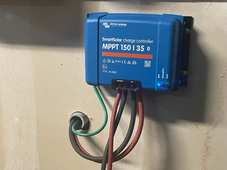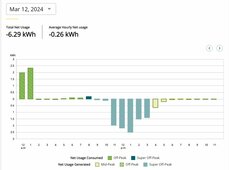You can do grid tied DC. That's what I'm planning to add to
Obviously, it has to get to AC at some point to tie to the AC grid, but there are quite a few different ways to get there.
A string type inverter would be a DC solar panel array feeding to a common single inverter. This is how most systems were before microinverters became reliable.
Do you want storage in the system?
If you do, then then I would suggest a hybrid system or "all in one". If I was starting from scratch, I would certainly look into something like the EG4 18K-PV or a Sol-Ark. Either of them will take a DC array, manage battery charging/discharging, and invert to AC with both grid export and off grid backup, all in a single box.
But with what I already have, I do like the Schneider XW-Pro inverter. But to get the same functionality, you need at least 3 devices. The XW-Pro, an "Insight" box to manage it, and an MPPT solar charge controller. There are advantages and disadvantages to the "All in One" vs the "Stack of Boxes" systems. If any part of an all in one fails, can it be serviced, or is it replacing everything? With the Schneider system, each component is separate, a failed MPPT charge controller has no effect on the XW-Pro inverter. But to match the capability, the cost adds up. The 18K-PV has 3 MPPT inputs at 6,000 watts each, that would be 3 expensive Schneider MPPT units. And the inverter is 12,000 watts, that is nearly two XW-Pro inverters. The built in transfer switch is 200 amps, the one in the XW can only do 70 amps, so triple again. The cost of the one box seems high, but to match it with the separates, adds up to more.
On the other hand, I also really like the Enphase microinverters. They provide all the UL protections for rapid shut down and arc stop along with per panel optimization. That requires an extra box at each panel with a DC string system. And the panel to AC line efficiency is hard to beat when the sun is shining. But for evening power, having to convert back to DC to a battery, and then back to AC again, makes it far less efficient. My current system is 4,800 watts of panels on microinverters and 2,000 watts on a DC charge controller. I would like to be more like 3,600 watts of each. Use most of the microinverter produced AC while the sun is up, and have the DC panels do all of the battery charging for the power used at night.
The All in One units have an advantage here. The MPPT charge controllers and the DC-AC inverter run on a common internal bus. Power that is going from Solar directly to AC is nearly as efficient as the Enphase inverters, AND the power that is directed into the battery, comes off the DC bus, without having to be inverted, so it is also, almost as efficient as a stand along MPPT charge controller. It is hard to argue with that advantage.
The only place the all in one systems seem to fall short is the over load capability. They pretty much all use high frequency inverters. For USA split phase, it is a separate inverter for the L1 and L2 outputs. That means the 12,000 watts is only ever 6,000 watts on each leg. While it has a fairly high over current surge capability, it is typically only for a few seconds at best. A single XW is not as powerful, but it can handle 12,000 watts for over 30 seconds, and 8,500 watts for 30 minutes. And you could pull the full 6,800 watts from just one leg for a short time as well. The very large and heavy transformer in the XW acts like a great filter and flywheel for the inverter output. The high frequency inverters lack that giant inductive flywheel.
With any PV solar power system, you really do need to start at the required output. What is the total load? Peak surge load? Long term power/energy demand? You need to find an inverter that can supply what you need, then provide enough battery to run it, and finally, enough solar panel to keep it charged up. I made a fairly big mistake with my initial Grid Tied PV solar install. Since we rarely have grid failures here, I didn't plan ahead for energy storage, and I was never told I would be forced to "Time of Use" billing and believed the hype about net metering saving me 70% off my electric bills with just a grid tied system producing 70% of my annual energy bill. Yes, it produced the promised 70% of my energy, but it only cut my bills by 30%. That happened because of the higher minimum power rate, and time of use rates that all PV solar customers are pushed on to in my area. It took me a few months to catch on to what was happening. Since they put me on "annual true up", my monthly bills were just $7.00 to $12.00 and it looked like I was saving a ton of money. BUT.... At the end of the year, I got hit with a bill over $1,500 to cover the evening electricity I was still buying from the grid. I only installed 4,800 watts of panels on 3,900 watts of microinverters. It should have been more like 7,000 watts of panels to export enough during the day to cover the evening cost. But self consumption with the battery is even better.




